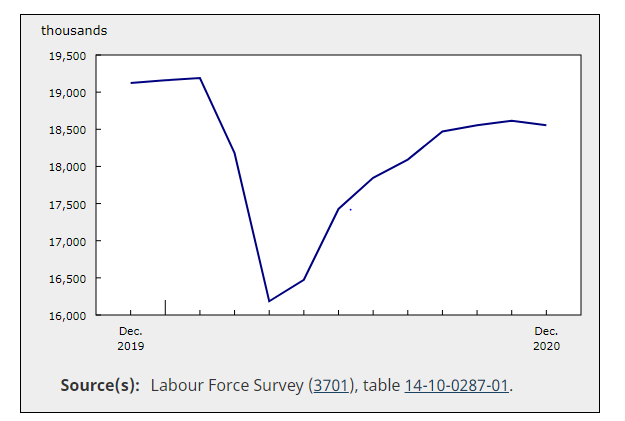The Pandemic Is Taking A Heavy Toll On Canadian Workers
The Canadian labour survey results for December are very disheartening. Many of the most important aspects of the Canadian labour market have been hit and hit hard. The unemployment rate remains largely unchanged, at 8.6%, because many workers just gave up looking for work and hence dropped out of the labour market. The job recovery started in the summer has lost momentum. The December survey’s reference period was Dec 6-12, prior to additional restrictions introduced in Ontario and Quebec to take affect on Dec 26. We can anticipate that a further deterioration in the Canadian labour market will show up in the January 2021 survey numbers.
Figure 1Canadian Employment Falls in December

Delving behind the headlines, the December report reveals how the pandemic has impacted key segments of the labour market, to wit:
*Employment fell by 63,000 in December—the first decline since April; we still remain below the pre-pandemic employment level;
*Part-time employment declined by 99,000, mostly due to losses among youth aged 15 to 24 (-58,000) and those aged 55 and older ( -27,000);
*Collectively, 1.1 million Canadian workers continue to be affected by the COVID-19 economic shutdown, either from job loss or reduced hours;
*total hours worked declined for the first time since April, falling 0.3% in December.
The service sector continues to shed jobs, losing an additional 74,000 last month. The public health restrictions had their greatest impact on hotel, food services, cultural and recreational industries. The only bright spot was an increase of 15,000 jobs in manufacturing Overall, there was no net increase in the goods-producing industries.
We are beginning to see early signs of the long-term impact on the workforce due to the pandemic. The changes in the labour force participation rate ---per cent of people counted as either employed or unemployed—continues to decline. Statistics Canada notes that women of working age and young male workers are leaving the workforce. The pandemic has been particularly harsh on women who have left the work world to care for families or have lost jobs in the service sector. Many workers, especially young people, have dropped out of the labour force because they are so discouraged in their job searches. There is the risk that a whole generation of new, young workers will not be able to find fulfilling jobs and satisfactory incomes in the coming years.
Another important long-term measure concerns the ‘labour underutilization ‘rate. This rate measures the portion of the potential labour force who are either unemployed or are employed but working less than half of the customary hours because of COVID-19 restrictions. That rate continues to hover around 20%, suggesting that much of the Canadian labour market is operating well below potential. Hence, we can expect that the Canadian economy will record much lower growth rates than experienced in the pre-COVID years. Our longer-term potential growth has been compromised by the pandemic.



